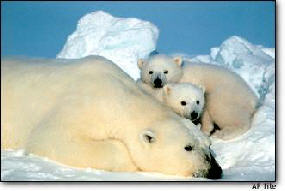|
Polar bears like this female and her cubs could be accumulating high levels of a toxic stain repellent. One study found the chemical in the liver of northern Alaskan bears.
The Arctic, already tainted by toxic chemicals like PCBs and DDT, is becoming the last stop for even more toxins, which are showing up in bears, whales and birds, according to a five-year assessment report by nations with Arctic regions. Two chemicals in particular stand out: one is used as a flame retardant in fabrics, TV sets, computers and other equipment; the second is a stain repellent.
“New contaminants are also showing up in the Arctic,” the report said. “These include brominated flame retardants in Canada, Greenland, the Faroe Islands, Norway ... and Sweden, as well as PFOS in North America and Svalbard (Norway).”
PFOS, which stands for perfluorooctane sulfonate, is used as a stain repellent. It’s worrisome because of its “extreme persistence. It does not seem to break down under any circumstances,” the authors said.
The report, which follows a first pollution overview in 1997, comes from a monitoring group of the Arctic Council, whose members are Canada, Denmark, Iceland, Norway, Sweden, Russia and the United States. Dozens of scientists from those countries contributed scientific data to the report.
The Arctic has long been known as a repository for a class of chemicals — called persistent organic pollutants, or POPs — that are carried to the region by air or ocean currents. The report provided new data to support earlier research showing that well-known POPs like PCBs and DDT are contaminating Arctic natives as well as polar bears, Arctic fox, seals, killer whales, harbour porpoises, seagulls and peregrine falcons.
Studies have shown the chemicals accumulate in the fat of mammals through breast-feeding and by eating animals lower on the food chain. “Some Arctic people are among the most highly exposed people on the globe because contaminants accumulate in their foods,” the report said.
Another concern is mercury emissions from power plants. The report’s authors said levels in the Arctic could increase if Southeast Asia continues to expand its power plant capacity.
Specifics about retardants
The report also raised a flag about the potential impact of two lesser-known chemicals now reaching the Arctic. The retardants in question are known as PBDEs, or polybrominated diphenyl ethers. These chemicals use bromine to prevent fabrics and equipment from burning.
“Data from seabirds, belugas and seals indicate that levels of the brominated flame retardant PBDE are increasing,” the report said.
The authors noted that use of brominated flame retardants has increased “drastically” in the past decade and annual worldwide production now
tops 200,000 tons, largely in northern industrial
areas.
“In some cases, brominated flame retardants can
leach into the environment, where some of them
are known to behave in a way that is similar to
PCBs,” the report said. “PBDEs seem to travel
over long distances in the atmosphere, and some
studies have shown that they can be toxic to the
immune system and can affect neurobehavioral
development.”
|

